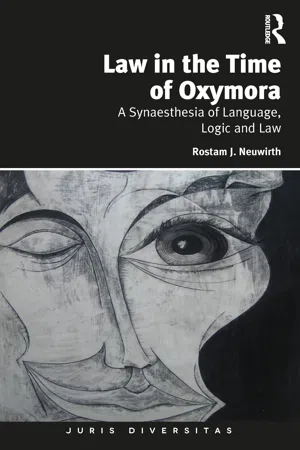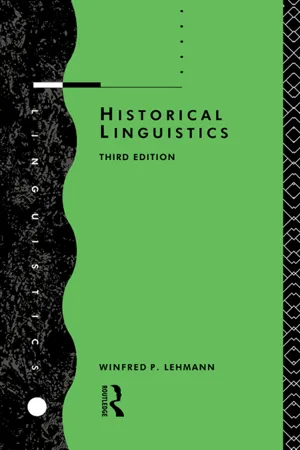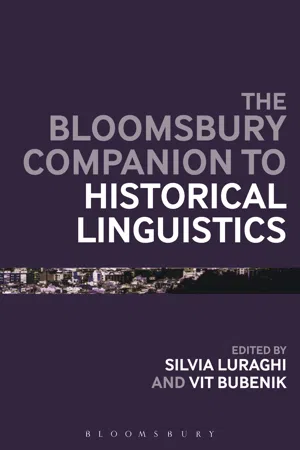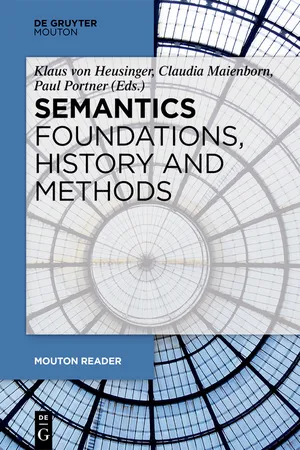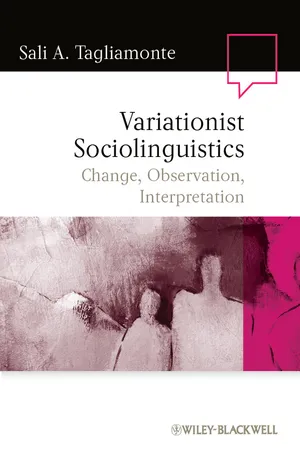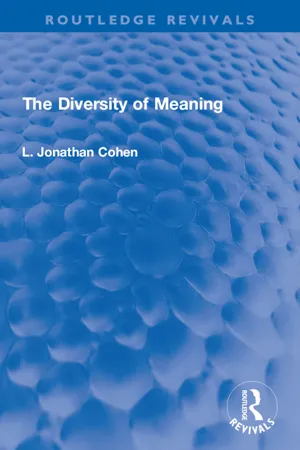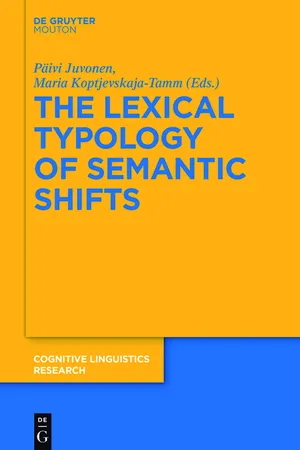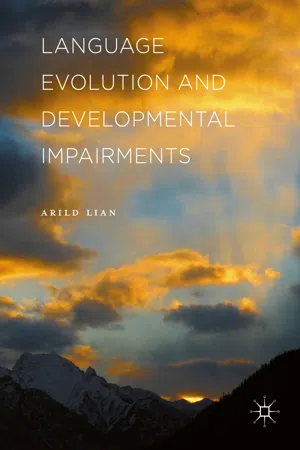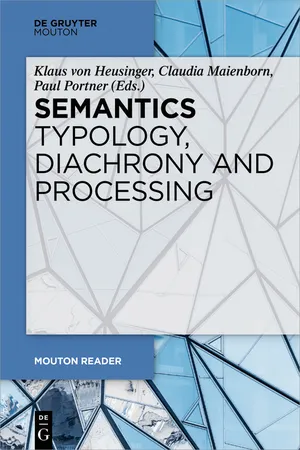Languages & Linguistics
Semantic Change
Semantic change refers to the evolution of the meaning of words over time. It can occur through processes such as broadening, narrowing, amelioration, or pejoration. These changes can be influenced by cultural shifts, technological advancements, or social developments, leading to shifts in the connotations and denotations of words.
Written by Perlego with AI-assistance
Related key terms
Related key terms
1 of 4
Related key terms
1 of 3
10 Key excerpts on "Semantic Change"
- eBook - ePub
Law in the Time of Oxymora
A Synaesthesia of Language, Logic and Law
- Rostam J. Neuwirth(Author)
- 2018(Publication Date)
- Routledge(Publisher)
This is known as “Semantic Change” or “semantic shift”, which means to keep old words but to fundamentally change the meaning attached to them. 21 Semantic Changes happen in different ways, such as widening or narrowing, or metaphor. 22 It has also been stated that Semantic Change often goes through a stage of polysemy, where a word has more than one meaning (like the French verb “baiser”). 23 An example of Semantic Change, which answers the question raised in the heading above is provided by the continued use of the terms “sunset” or “sunrise”. The reason is that, following the replacement of a geocentric by a heliocentric world view, the phenomenon observed should actually mean and, therefore, be replaced by the terms “earthrise” or “earthset”. p.115 Generally, the explicit change of language as reflected in the creation of neologisms is more relevant to the emergence of essentially oxymoronic concepts. Nonetheless, even Semantic Change in its different forms may be relevant in both oxymora and paradoxes. This is also reflected in the distinction between paradoxes of language (semantic paradoxes) and paradoxes of mathematics (logical paradoxes). 24 Returning to change, an interesting aspect of its nature, at least within the confines of the current framework of perception made of time and space, the opposite trend can also be possible. This is when language or literature creates new words before they have become reality or are even found to exist. A first example of this kind includes “quark”, as coined by James Joyce in Finnegans Wake, which was later used in theoretical physics to denote a hypothetical particle, the fundamental building block of all matter. 25 This possibility is not only interesting in terms of human ingenuity and the ability to predict future events but also closely related to the normativity of law - eBook - ePub
Historical Linguistics
An Introduction
- Winfred P. Lehmann(Author)
- 2013(Publication Date)
- Routledge(Publisher)
robin, (mountain) lion , and so on changed in meaning when English speakers brought these terms to America. The relationship between Semantic Change and other cultural change adds a complexity to the study of change in meaning that is not found in the study of change in phonological, morphological and syntactic systems.It is hardly surprising, therefore, that general principles have not been determined for Semantic Change. Modifications in the means of indicating meaning are associated with modifications in the lexicon, and for these we can propose some general patterns, as will be apparent later in the chapter. But rules have only recently been proposed; they are restricted to small sets like kinship terms. Further such rules may be expected as the study of Semantic Change is pursued with the rigor applied to phonological, morphological and syntactic change.To deal with the complexity of Semantic Change, three terms are used: (1) the word , or linguistic symbol; (2) the referent denoted by a word, whether concrete like “pen” or abstract like “thought”; (3) the reference , or notion symbolized. Each of these may change, as examples given below will illustrate. A word like OE ēam “uncle” may be lost; a referent like a feather may be replaced by a plastic cylinder with a point; a notion associated with an object, like a bear, may come to convey dread, and changes in the designation may result. In dealing with Semantic Changes, the meanings of words have come to be expressed increasingly by means of features.13.2 CHANGE IN SEMANTIC FEATURES
In proposing a framework for semantic analysis, fields have been analysed for their distinctive features. If we analyse the kinship system for Modern English in this way, we would propose the features: gender, generation, lineality, The basic set of kinship terms may be presented in a matrix as follows: - eBook - ePub
- Laurel Brinton, Alexander Bergs(Authors)
- 2017(Publication Date)
- De Gruyter Mouton(Publisher)
Elizabeth Closs TraugottChapter 7: Semantics and Lexicon
Elizabeth Closs Traugott: Palo Alto (USA)1Introduction 2Cognitive semantics and metaphor 3Invited inferencing and conceptual metonymy 4Collocation and collostructional analysis 5Productivity of Semantic Changes at specific periods 6Differences between lexical and grammatical changes 7Changes in the lexicon 8Future prospects 9ReferencesAbstract :Selected topics in research on Semantic Change are discussed with focus on work based in Cognitive Linguistics and neo-Gricean pragmatics. Recent work on metaphor and metonymy, grammaticalization, subjectification, and collostructional analysis are highlighted and shown to provide theoretical underpinnings for some traditional taxonomies of Semantic Change. As the inventory of form-meaning pairs in a language, the historical lexicon reflects Semantic Change; it also reflects how vocabulary size has changed in English, and how borrowings have affected the typological ways in which meanings are packaged into words.1Introduction
While meaning or “semantics” has been a central concern of philosophy since early Greek times, Semantic Change has been a subject of investigation for little more than a hundred years. A landmark work is Bréal (1964 [1897]), in which a taxonomy of Semantic Changes was developed (and revised in structuralist terms by Ullmann 1964) that has in essence been repeated in most textbooks and handbooks on language change (e.g. Hock and Joseph 2009 [1996]; Campbell 2013 [2004]; Fortson 2003). Key concepts include change due to metaphor (e.g. tissue ‘woven cloth’ > ‘aggregation of cells in animals or plants’) and metonymy (e.g. board ‘table’ > ‘people sitting around a table, governing body’), pejoration (conceit ‘(self)concept’ > ‘overestimation of one’s qualities’) and amelioration (e.g. ME nice ‘foolish’ > ‘pleasant’), narrowing (e.g. OE mete ‘(solid) food’ > ‘food derived from animals’) and broadening (e.g. ME bridde ‘nestling’ > bird ), and taboo avoidance (e.g. 16th century toilet ‘cloth’ > 17th century ‘cloth covering for dressing-table’ > 18th century ‘dressing-table’ > 19th century ‘lavatory’ (a euphemistic use) > 20th century ‘bathroom fixture’). Often several types of change affect one item, e.g. the changes to toilet - Silvia Luraghi, Vit Bubenik(Authors)
- 2013(Publication Date)
- Bloomsbury Academic(Publisher)
13 4.1 Linguistic CausesAs we saw in previous paragraphs (sections 2.1.4 and 3.1), sometimes Semantic Change is language-induced. Ullman (1962) treated under this heading the phenomenon of contagion, to which ellipsis should also be added. In these cases, there does not seem to be any external motivation for Semantic Change—it is just linguistic mechanisms at work that provoke a reassignment of the meanings of words.4.2 Non-linguistic Causes Very frequently, causes of linguistic change are nonlinguistic. These causes can be broadly classified into three groups: historical, social and psychological causes. 4.2.1 Historical CausesSemantic Change can be brought about by a change in the referents of a word themselves. Words tend to be conservative in the sense that they usually remain in a language even if the reality that they refer to undergoes variations. A king in a contemporary democratic society has not the same functions as in earlier societies nor do institutions such as parliaments or courts; however, the same words are used for them. This also applies to objects or concepts and ideas—the word pen (or Spanish pluma ‘pen’) has been kept even if bird pens have not been used for writing for a long time. So has humor , even if the physiological theory of the four humors was given up centuries ago.4.2.2 Social and Psychological Causes In a certain sense, every Semantic Change has a social base—individual innovations are being produced constantly, but they need to spread throughout the community if they are to stay in the language.However, from a more specific perspective, words can acquire new or different meaning in specific social groups. Slang or technical languages are good examples of this type of processes. Those innovations can remain inside the original group of speakers or else expand to the whole community of speakers. French farming language provides a good instance of such processes, as shown by the Semantic Changes in (5).- eBook - ePub
- Klaus Heusinger, Claudia Maienborn, Paul Portner(Authors)
- 2019(Publication Date)
- De Gruyter Mouton(Publisher)
It was in this process that ‘words changed their meanings’. Hence the laws of Semantic Change were no longer regarded as ‘natural’ or ‘logical’ laws, but as intellectual laws (Bréal 1883), or what one would nowadays call cognitive laws. This new psychological approach to semantic problems resembled that advocated in Germany by Steinthal, Paul and Wegener. Paul, Wegener, Darmesteter, and Bréal all stressed that the meaning of a word is not so much determined by its etymological ancestry, but by the value it has in current usage, a point of view that moved 19th-century semantics slowly from a purely diachronic to a more synchronic and functional perspective. Although Bréal and Wegener seem not to have known each other’s work, their conceptions of language and of semantics are in some ways astonishingly similar (they also overlap with theories of language developed by Whitney in the United States and Johan Nicolai Madvig (1875) in Denmark, see Hauger 1994). Brought up in the framework of traditional German comparative linguistics, both objected to the reification of language as an autonomous self-evolving system, both saw in psychology a valuable help to get an insight into how people speak and understand each other and change the language as they go along, both made fruitful use of the form-function distinction, where the function drives the evolution of the linguistic form, both assumed that to understand a sentence the hearer had much more to do than to decode it word by word – s/he has to draw inferences from the context of the sentence as a whole, as well as from the context of its use or its function in discourse –, and, finally, they both had a much broader conception of historical semantics than their contemporaries, especially some of the semasiologists in Germany and the ‘ideologists’ in France. In their eyes Semantic Change is a phenomenon not only of the word or idea, but must be observed at the morphological and syntactical level, too - eBook - ePub
Variationist Sociolinguistics
Change, Observation, Interpretation
- Sali A. Tagliamonte(Author)
- 2011(Publication Date)
- Wiley-Blackwell(Publisher)
The CRE holds “only for contexts in which the surface forms are reflexes of the same underlying grammatical alternation” (Pintzuk 2003: 515). The claim concerns the frequency of the incoming form only and does not consider the multiple constraints that may be operating on the variation. In essence, the display shown here provides a diachronic perspective on the constraint ranking of a single linguistic pattern (linguistic contexts a, b, and c) over time. The CRE and related research in historical syntax is the most comprehensive integration of LVC research and syntactic theory.The study of syntactic variation of this magnitude requires large historical corpora that represent hundreds of years of data in real time. Early corpora of this type include the Helsinki Corpus and the Corpus of Early English Correspondence. The Research Unit for Language Variation and Change at the University of Helsinki in Finland provides a Corpora Resource Database (CoRD) which lists a remarkable array of corpora.1 More recently, large multi-university projects have developed which aim to produce syntactically annotated corpora for all stages of the history of English.2 As we move into the future the study of change over time will become more possible.Mini Quiz 3.2Q1 The constant rate effect refers to:(a) An effect which measures the frequency of a given variable in historical context. (b) The process by which the frequency of linguistic variables is measured. (c) The idea that language is constantly changing. (d) The idea that linguistic change happens at the same rate across different constructions. (e) The idea that linguistic change happens at different rates across different constructions.Semantic ChangeSemantic Change shifts the meaning of words so that they acquire “new or broader meanings” (Hock and Joseph 1996: 228). A number of different mechanisms underlie Semantic Change. The foremost of these are metaphor and metonymy.Metaphorical and Metonymic ExtensionMetaphor involves similarity across domains whereas metonymy involves shifts within the same domain (Traugott and Dasher 2002: 78). In metaphorical extension words shift from one domain to another based on similarity – a calm lake → lake as calm as glass . In metonymic extension one word is used for another within the same domain based on some relationship or association between them – the crown of a queen → crown = queen. These are typical examples found in textbooks; in real life mundane examples are everywhere. Consider the metaphors in Example 3.18a or the metonymy in Example 3.18b (see also Chapter 1, Example 1.4). There are various other processes: litotes change words from stronger to weaker meaning (brutal = bad); see Chapter 4 and also Example 3.18c; hyperbole changes words from weaker to stronger meaning (see variable (intensifiers) in Chapter 11); degeneration makes words into something less than they were before (kill = get upset with ); and elevation makes them into something more (hit = kill - eBook - ePub
- L. Jonathan Cohen(Author)
- 2021(Publication Date)
- Routledge(Publisher)
First, since the norms of good style, though not irrelevant to speech, have most often been invoked in the criticism of literature, it is easier to separate the science of language from the criticism of style if linguists are supposed to study the spoken word rather than the written one. Secondly, even outside literature written utterances tend to be more standardized in language than do spoken ones: we thus take advantage of their relative permanence and achieve communication over much wider stretches of space and time. Those who concentrate their interest on speech are therefore less likely to be preoccupied with the problem of norms and more open-minded in discerning variation. No doubt the reaction here too, as in the case of the historical movement, has been somewhat excessive. But when linguists return, as some of them are now doing, 1 to the study of written language they are interested in facts not rules, in how people do write, not in how they ought to write. The meaning of a language-word, therefore, to a modem lexicographer or grammarian is a changeable property. That is why he can discuss, as Herder’s predecessors could not, how a decline in the relative importance of pastoral wealth extended the meaning of the Latin word ‘pecunia’, or how the use of the rosary gradually changed that of the English word ‘bede’ or ‘bead’. 2 Whereas the causal liaisons of Semantic Change were beyond the conceptual reach of those who treated meanings as unchangeable properties, they are now a familiar topic of research – because it is generally accepted that a word may remain the same while changing its meaning. If a word itself changes, its continuity through change is now normally thought to consist in similarities of form alone rather than in those conjoined with identity of meaning - eBook - ePub
- Päivi Juvonen, Maria Koptjevskaja-Tamm(Authors)
- 2016(Publication Date)
- De Gruyter Mouton(Publisher)
during the borrowing process itself. There is, typically, reanalysis in the contact situation, whereby certain elements from the context characteristic of the source culture and/or the relevant extra-linguistic reality are read into the word meaning, the outcome being either specialization (e.g. (62)) or metonymic change (e.g. (63); cf. Winter-Froemel 2014):(62)Sp. sombrero ‘hat’ → Engl. sombrero ‘Mexican hat’(63)Engl. flipper ‘lever in a pinball machine’ → Germ. Flipper ‘pinball machine’2.3.6Causes, nature, and consequences of meaning change
As a first approximation, we can, after Ullmann (1964), distinguish between the causes, nature, and consequences of meaning change.2.3.6.1Causes/motivations of meaning change/innovation
As far as causes are concerned (cf. Ullmann 1964: 197–210), it should first be made clear that we are not actually dealing with the causes of the completed change, but at best the causes of the underlying innovation (cf. also Blank 1997: 370 f.; see 2.3.1 .). Thus Blank (1999a; cf. also 1997: 345–405) speaks rather of the ‘motivations’ for lexical Semantic Change and, revising Ullmann’s proposals, in particular from a pragmatic and cognitive-semantic point of view, mentions the following factors: (i) new concepts; (ii) abstractness of concepts/low accessibility of referents; (iii) sociocultural change; (iv) close conceptual/factual relations (frames, prototypicality, blurred boundaries); (v) inherent problems in the lexicon (complexity of words, lack of motivation, lexical gap); (vi) emotionally marked concepts (expressivity, taboo).A clear distinction should be made between onomasiological and semasiological perspectives (section 2.1.2 .): are we dealing with motivation for an innovation of designation or motivation for a meaning innovation? The distinction between innovations by the speaker and innovations by the hearer is now important (see 2.3.2 .). In addition, a distinction should be made between motivation for the fact of meaning innovation as such and motivation for a particular type - eBook - ePub
- Arild Lian(Author)
- 2016(Publication Date)
- Palgrave Macmillan(Publisher)
When words are treated as objects, they may also serve as tools which can be applied to other objects. Language has become de-contextualized from events of vocal behavior. Thus, words can be used to describe other words; that is, the feature of reflexivity becomes an important attribute of language, and most probably the awareness of this attribute has depended on the invention of writing. Prior to this invention, or prior to the common use of written language, there is no evidence of languages which contained the feature of reflexivity.5.4 The Meaning of Words as Concepts: A Cognitive Approach
As pointed out above the study of meaning in the semantic/linguistic tradition generally implies a reference to linguistic units; that is, words, phrases, sentences, and so on. In the following, I will argue that semantic meaning within a cognitive research tradition always implies a reference to concepts and categories. This research tradition focuses on concepts and learning of concepts both within language and nonlanguage domains. Also in this tradition, the learning of concepts or categories by animals are compared to the learning of concepts by humans. That is why the cognitive approach agrees with an evolutionary perspective on semantic meaning. However, the linguistic/semantic and the cognitive approach to meaning are reconcilable approaches. I consider them to be supplementary and therefore both provide important frameworks for addressing problems of semantic development and evolution. Studies of concepts and concept learning within nonlinguistic domains have a long history in cognitive psychology. Remember that Ullman argued that language shares important biological and computational substrates with memory, commonly considered to be a nonlanguage domain. His procedural/declarative (PD) model has gained much support, particularly in relation to grammar (see Chap. 3 - eBook - ePub
- Klaus Heusinger, Claudia Maienborn, Paul Portner(Authors)
- 2019(Publication Date)
- De Gruyter Mouton(Publisher)
As new uses of words often emerge against the background of common assumptions, the building-up of common ground is an important aspect of semantic innovation. By using this kind of apparatus one could, for example, model a very frequent type of Semantic Change which consists in the emergence of new evaluative uses of expressions originally used descriptively. Take a noun like (young) servant, which serves to refer to persons of a certain social status: If in a given speaker community the assumption becomes common knowledge that such persons frequently show criminal tendencies, this expression can be used to accuse someone of being a criminal, which in time may become a conventional use of the word. This kind of development is frequently found in various languages (cf. Middle High German buobe and schalk, English knave and varlet, French gars). A similar process permits descriptive adjectives to be used in evaluative function, which is also a very frequent type of meaning change. A second trend in recent formal semantics and pragmatics is the interest in “systematic polysemy”, especially in the various uses of words based on metonymic relations, e.g. uses of expressions denoting institutions like the university to refer to the buildings housing this institution or to the members of this institution. Recent analyses of this kind of polysemy include Nunberg (1995), Pustejowsky (1995), Copestake & Briscoe (1996), Blutner (1998) and Peters & Kilgarriff (2000). In historical semantics, awareness of this type of polysemy and its regular character goes back to its very beginnings in the 19 th century, so historical semantics has much to offer in terms of historical data for this kind of phenomenon. On the other hand historical semantics could profit from relevant theoretical work and from work on large present-day corpora
Index pages curate the most relevant extracts from our library of academic textbooks. They’ve been created using an in-house natural language model (NLM), each adding context and meaning to key research topics.
Explore more topic indexes
Explore more topic indexes
1 of 6
Explore more topic indexes
1 of 4
